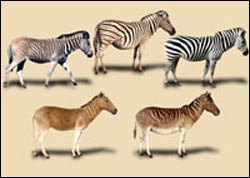How a zebra lost its stripes: Rapid evolution of the quagga

Current living zebras (top row), extinct quaggas (bottom row)
DNA from museum samples of extinct animals is providing unexpected information on the extent and effect of the Ice Age as well as the path of species evolution, according to a report by scientists from Yale University, the Smithsonian Institute and the Max Planck Institute for Evolutionary Anthropology.
The quagga, Equus quagga, a South African relative of horses and zebras, having a front half with zebra-like stripes and a back section like a horse with no marking, became extinct about 100 years ago. The pelt from a quagga museum specimen was the subject of tissue sampling that launched the field of ancient DNA analysis.
“Twenty years ago this exact species opened the field of ancient DNA studies on extinct animals,” said one of the authors, Gisella Caccone, senior research scientist in the Department of Ecology and Evolutionary Biology at Yale. “Now, thanks to technological advances in the field, we revisited the story and used a population level approach to this question by analyzing a larger fragment of DNA and multiple specimens.”
In the past, the quagga has alternatively been described as a species and a subspecies of the Plains zebra.These researchers asked how and when the quagga diverged from all the remaining related horses, zebras, and asses. They compared the genetics, coat color and habitats of existing zebras with related extinct species.
The mitochondrial DNA markers from 13 museum specimens, including the only skeleton in museum collections, which is at Yale’s Peabody Museum of Natural History, showed that quagga likely diverged from Plains zebra about 120,000 to 290,000 years ago during the Ice Age. These results suggest that the quagga descended from a population of plains zebras that became isolated and the distinct quagga body type and coloring evolved rapidly.
This study reveals that the Ice Age was important not just in Europe and North America, but also in Africa.
“The rapid evolution of coat color in the quagga could be explained by disrupted gene flow because of geographical isolation, an adaptive response to a drier habitat, or a combination of both of the two forces,” said Caccone.
Media Contact
More Information:
http://www.yale.eduAll latest news from the category: Life Sciences and Chemistry
Articles and reports from the Life Sciences and chemistry area deal with applied and basic research into modern biology, chemistry and human medicine.
Valuable information can be found on a range of life sciences fields including bacteriology, biochemistry, bionics, bioinformatics, biophysics, biotechnology, genetics, geobotany, human biology, marine biology, microbiology, molecular biology, cellular biology, zoology, bioinorganic chemistry, microchemistry and environmental chemistry.
Newest articles

Bringing bio-inspired robots to life
Nebraska researcher Eric Markvicka gets NSF CAREER Award to pursue manufacture of novel materials for soft robotics and stretchable electronics. Engineers are increasingly eager to develop robots that mimic the…

Bella moths use poison to attract mates
Scientists are closer to finding out how. Pyrrolizidine alkaloids are as bitter and toxic as they are hard to pronounce. They’re produced by several different types of plants and are…

AI tool creates ‘synthetic’ images of cells
…for enhanced microscopy analysis. Observing individual cells through microscopes can reveal a range of important cell biological phenomena that frequently play a role in human diseases, but the process of…





















